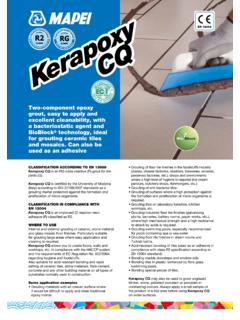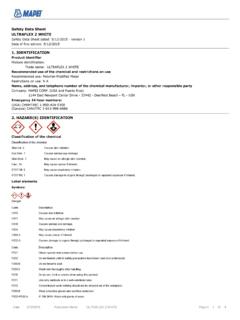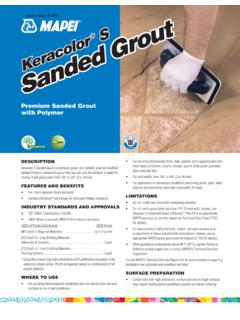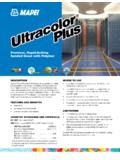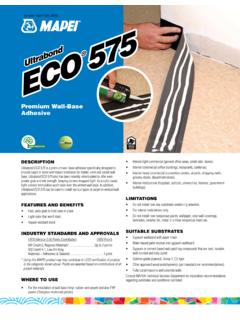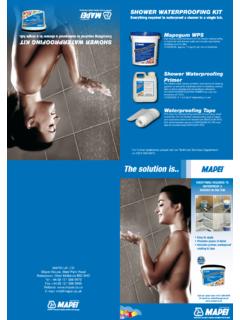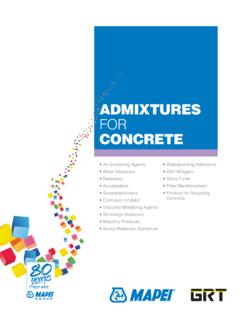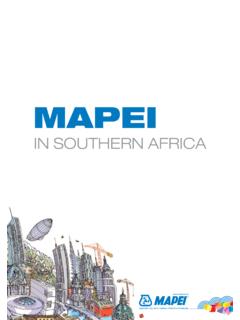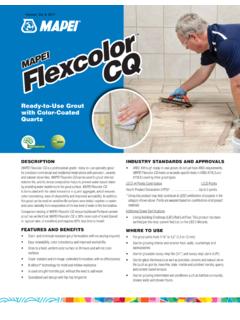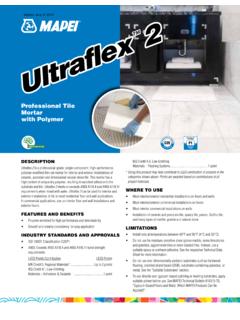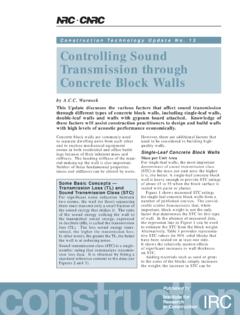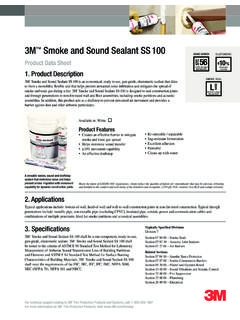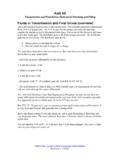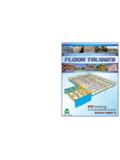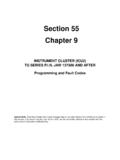Transcription of Premium Crack-Isolation and Sound-Reduction …
1 DESCRIPTIONM apeguard 2 is a next-generation, flexible, thin, 40-mil (1-mm) lightweight, load-bearing, fabric-reinforced peel-and-stick Crack-Isolation membrane. After application, ceramic tile or stone can be installed immediately with any polymer-modified cement-based mortar. Glue-down wood flooring can also be installed with any MAPEI urethane adhesive. Mapeguard 2 helps to prevent existing or future in-plane floor cracks (with movement up to 3/8" [10 mm] wide) from transmitting through grout, ceramic tile or natural stone. It also reduces the transmission of impact sound (footsteps, dropped objects, etc.) and airborne sound (voice, TV, etc.) through floors when installed under ceramic tile, stone or wood floor coverings. FEATURES AND BENEFITS Dual protection Provides crack isolation and sound reduction Lightweight 35% lighter than previous generations of comparable membranes Semi-rigid sheet Easy to position on floor and cut to size Split-back release film Installs faster than membranes with 1-piece liners White surface Easy to view under lower-light conditions Thin-film adhesive backing Bonds to a variety of substrates Time-saving Prime, peel, stick and then install tile or wood immediately No odor Great for confined spaces Contains post-industrial recycled materialINDUSTRY STANDARDS AND APPROVALSASTM C627 (Robinson): See Product Performance Properties section for Mapeguard 2.
2 ASTM E492-04 (Impact sound ), E90-04 (Airborne sound ), E2179 (Impact sound ): See Product Performance Properties section for Mapeguard 2. ANSI ( crack isolation For Tile & Stone): See Product Performance Properties section for Mapeguard 2. Mapeguard 2 exceeds the high-performance standard for crack Points Contribution LEED PointsMR Credit 4, Recycled Content* ..Up to 2 points* Using this MAPEI product may help contribute to LEED certification of projects in the category shown above. Points are awarded based on contributions of all project TO USE Residential (homes, apartments, condominiums) and commercial (airports, malls, office buildings, restaurants, galleries) floors, both interior and exterior (with proper drainage) Ideal for multi-family or multi-story buildings to reduce noise transmission through floorsLIMITATIONS (for Mapeguard 2, MAPEI SM Primer and MAPEI SM Primer Fast) Do not use over cracks or control joints subject to: out-of-plane movement; or in-plane movement greater than 3/8" (10 mm).
3 Note: See Expansion Joints Crack-Isolation and Sound-Reduction Sheet MembraneMapeguar d 2 Mapeguar d 2TM Do not use over substrates containing asbestos, plank wood flooring, presswood, particleboard, chipboard, oriented strand board (OSB), pressure- or oil-treated plywood, Lauan plywood, Masonite, self-stick tile, laminate, metal or fiberglass surfaces, or poured epoxy floors or similar dimensionally unstable materials. Do not use where excessive substrate moisture and/or where negative hydrostatic pressure exists. The maximum amount of acceptable moisture in a concrete substrate for Mapeguard 2 primed with MAPEI SM Primer is 5 lbs. per 1,000 sq. ft. (2,27 kg per 92,9 m ) per 24 hours as determined by a calcium chloride test kit. The maximum amount of acceptable moisture in a concrete substrate for Mapeguard 2 primed with MAPEI SM Primer Fast is 8 lbs.
4 Per 1,000 sq. ft. (3,63 kg per 92,9 m ) per 24 hours as determined by a calcium chloride test kit. When moisture vapor emissions are in excess of 8 lbs. per 1,000 sq. ft (3,63 kg per 92,9 m ) per 24 hours, call MAPEI s Technical Services for recommendations. Do not use on vertical surfaces; under glass tile installations; as a waterproofing or roof deck membrane or wear surface; for submerged applications; or on plywood in exterior applications. Do not use on exterior floors with improper drainage (no standing water). When using Mapeguard 2 over gypsum-based floor-patching or leveling compounds, reference Technical Bulletin #010313-TB ("Gypsum-Based Floors and Walls: Which MAPEI Products Can Be Applied?"). Do not use Mapeguard 2, MAPEI SM Primer or MAPEI SM Primer Fast with solvent-based materials.
5 Do not use self-leveling products over Mapeguard 2. Do not use premixed products to set tile over Mapeguard 2. Do not install moisture-sensitive tile or stone with water-based setting : On occasion, dimensionally weak natural stone tile that normally would not be categorized as moisture-sensitive (such as travertine, limestone, marble and agglomerates) can exhibit doming, cupping or curling when wet-set or medium-bed mortar methods of installation are used over impervious sheet membranes such as Mapeguard 2. For this reason, areas requiring more than 3/8" (10 mm) buildup require the use of a self-leveling underlayment or cured mud-bed application before installation of Mapeguard 2. When installing natural stone, always do a mockup area of the proposed installation and allow materials to reach a full cure to ensure achieving the desired effect.
6 For more information regarding these methods or materials, contact MAPEI s Technical Services before installation or SUBSTRATES Fully cured concrete (at least 28 days old) Cement mortar beds and leveling coats Cement backer units (CBUs) see manufacturer s installation guidelines Properly prepared cement terrazzo floors, and well-bonded ceramic tile and natural stone; and vinyl composition tile Exterior-grade plywood for interior residential floors and countertops in dry areas only. Plywood must be Group 1, CC-type, conforming to APA classification and Product Standard PS 1-95 or CANPLY exterior plywood Select or Select Tight Face conforming to CSA-0121 standard for Douglas fir. (See TCNA Handbook for additional information and following statement regarding deflection.) Consult MAPEI s Technical Services Department for installation recommendations regarding substrates and conditions not Council of North America (TCNA) Statement on Deflection CriteriaFloor systems, including the framing system and subfloor panels, over which tile will be installed should be in conformance with the IRC [International Residential Code] for residential applications, the IBC [International Building Code] for commercial applications, or applicable building.
7 The owner should communicate in writing to the project design professional and general contractor the intended use of the tile installation, in order to enable the project design professional and general contractor to make necessary allowances for the expected live load, concentrated loads, impact loads, and dead loads including the weight of the tile and setting bed. The tile installer shall not be responsible for any floor framing or subfloor installation not compliant with applicable building codes, unless the tile installer or tile contractor designs and installs the floor framing or PREPARATION 1. All suitable substrates must be smooth, structurally sound and free of any substance that could prevent Do not use chemical means (acid etching or stripping) to prepare approved substrates.
8 Use mechanical methods To remove any bond-inhibiting materials, mechanically clean and prepare concrete substrates by diamond-cup grinding or other engineer-approved methods to obtain the International Concrete Repair Institute (ICRI) concrete surface profile (CSP) #2. When concrete requires more mechanical preparation, the profile will typically increase. In such cases, the surface should be made smooth by applying Planipatch powder mixed with diluted Planipatch Plus liquid (1 part Planipatch Plus liquid per 3 parts water). For large areas, consider using one of MAPEI s self-leveling underlayments. See respective Technical Data Sheets (TDSs) for more For details, see MAPEI s Surface Preparation Requirements document in the Product Information section of the Tile & Stone Installation Systems page on MAPEI's d 2 Mapeguar d 2 PRODUCT APPLICATION Apply when substrate and ambient temperatures are between 40 F and 95 F (4 C and 35 C).
9 Install Mapeguard 2 only in conjunction with undiluted MAPEI SM Primer or MAPEI SM Primer Fast. Allow MAPEI SM Primer or MAPEI SM Primer Fast to dry tacky before installing Mapeguard Individual crack isolation before installing tile Mapeguard 2 may be applied directly to the substrate area that has existing in-plane cracks (with movement up to 3/8" [10 mm] wide). Cut Mapeguard 2 to size so that the length and width of the membrane will cover the entire length and width of the crack , plus 3 times the width of the largest tile being used. Center the cut membrane over the crack s width and length. Mark on the floor where the membrane is to start. Set aside precut sections (or entire rolls) of Mapeguard 2. Continue with installation instructions at Step Full-floor crack isolation (or sound reduction) To effectively isolate and protect an entire tile installation from existing or future substrate cracks, and to achieve effective sound reduction, Mapeguard 2 must be installed over 100% of the substrate that will be covered with ceramic tile or stone.
10 For effective sound reduction, an approved acoustical sealant should fill gaps between end of tile or wood and walls, columns, etc. Unroll Mapeguard 2 and cut it to size for the substrate to be tiled. For easier handling and installation, each roll may be cut into shorter lengths (such as 10 feet [3,05 m]) before installation. Ensure that all edges or ends of each roll abut edges or ends of other rolls. To ensure a flat surface and proper sound reduction, do not overlap edges or ends from one roll onto another. Number each sheet and mark its starting point on the floor. Set aside precut sections of Mapeguard MAPEI SM Primer or MAPEI SM Primer Fast application Using a roller or brush, prime the clean, properly prepared substrate with MAPEI SM Primer or MAPEI SM Primer Fast. Allow the primer to dry until tacky (about 10 to 15 minutes).
